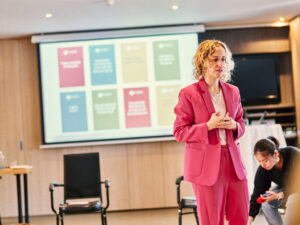Think you can innovate by appointing an innovation manager? Or by rolling out an innovation process? Forget it. The organizations that tried, have all since backtracked. And those still intending to approach innovation in the same way, should think twice. What you really need is room for experimentation. Businesses that truly excel in terms of innovation have the courage to fundamentally question things, to try new ideas, to fail, and to learn from it.
Want to change the world? Then start by changing your own
Innovation is a practice that has to work its way into the very fabric of an organization. Experimentation plays a crucial role, and must therefore be second nature to employees. Something that’s applied twenty-four seven – with enthusiasm and dedication.
There’s no innovation without experimentation. Innovation is about breaking away from what’s familiar. Not only in your mind. On the contrary, you have to act different to think different. Thinking differently and acting differently are not independent activities. One naturally follows on from the other. Do things you wouldn’t normally do. Or the things you normally do, in a different way. And you’ll automatically obtain a fresh perspective.
Marvel at what’s happening around you
Don’t experiment for experiment’s sake. Observe what’s happening around you with an open mind. What new opportunities are emerging? Which previously overlooked solutions now suddenly present themselves? And what can you learn from them? About your current way of working and its shortcomings, for example. Or about the limitations of existing processes and practices, and how to escape them.
You’ll feel happier, incidentally, as a result. And so will the rest of your organization. Psychological research suggests that when you focus on a problem, it negatively impacts your state of mind. Your brain tenses up and your emotions go into a downward spiral. You feel limited and restricted, quite literally. In contrast, when you focus your attention on opportunities and alternative solutions, it creates a sense of freedom and possibility. In fact, experimentation is arguably the finest antidote to declining employee satisfaction levels and lack of motivation there is.
Facilitate experimentation and learn to value it
Either create an environment that naturally facilitates experimentation, or don’t bother at all.
Many of our organizations’ structures and processes actually create huge obstacles to experimental behavior. Organizational structures are created to provide order and give clear roles to everyone and everything within the organization. Structure is certainly an effective way to ensure that your business is manageable and predictable. So, this definitely presents a challenge for organizations that wish to remain efficient. But structure can also stand in the way of efficiency. Indeed, the sustained success of an organization depends on its capacity for innovation more than ever before. Yet, as we now know, innovation demands experimentation, and tensions that are palpable in every modern workplace can flare as a result. Unfortunately, most businesses try to overcome this with more of the same. They try to structure and organize the innovation process. By establishing an Innovation Board, rolling out an innovation process, or determining who is permitted to engage in innovation. In so doing, they serve to ensure that innovation remains nothing more than a strategic intent. If you set something in stone, it will never come to life.
Whilst there’s no panacea for creating an environment that facilitates experimentation and encourages inherent innovation, there are a number of ways to catalyze it.
1. Involve the entire organization
If you (as a leader) think that you must control who can and cannot join the ‘experimenters club’, then you need to think again. Do you really believe that you’ll be able to innovate with a select group of senior leaders and a handful of budding high potentials? Such selective casting immediately mortgages your experiment. Thinking and acting differently is far more likely to succeed in the company of a motley crew with varying skills, experience and backgrounds. Unfortunately, this kind of diversity is often in short supply at the top of the pyramid. Engage your entire organization. Invite all of them to roll up their sleeves. You’ll be amazed at the wealth of ideas it generates.
2. Free up time
Pioneers in innovation systematically free up time and space for experimentation. They not only actively devote time to experimentation, they also give their employees the freedom to conduct experiments as they see fit.
Innovation demands time and mental space. The sting, however, lies in the fact that the immediate return from tinkering with existing practices and systems is greater – or at least perceived to be greater – than trying out new things over the longer term. If we take a closer look at leading businesses, however, the case becomes clear. 3M and Google systematically allocate every employee 10% of “free time” for experimentation. And Intuit even goes so far as to grant three months’ experimentation time to their finest ‘corporate intrapreneurs’. Not as ‘reward’, but because they know it will pay off.
Want some hard numbers? Then check out the Forbes World’s Most Innovative Companies List and how it’s ranked according to the ‘innovation premium’. (And no, it doesn’t only contain the usual Silicon Valley suspects. In fact, quite the opposite.)
3. Learn to value experiments
Innovative organizations value experiments, and not only successful ones. They share both successful and unsuccessful experiments with their entire organization and openly appreciate those who’ve worked on them. No experiment is considered a failure. Because even those initiatives that don’t generate tangible business results, can still deliver added value. It might be in the form of heightened learning for example, or increased insight into (potential) technology solutions, new markets, or the talents of those involved.
4. Develop the right muscles
Clayton Christensen from Harvard Business School and Hal Gregersen from MIT Sloan have been researching the innovator’s ‘DNA’ for years. According to their research, it comprises five key skills: associating, questioning, observing, networking, and experimenting.
And the latter is simply not possible without first mastering the other four. Essentially, they are ‘mental muscles’ that must each be individually developed.
Unfortunately, we rarely make time for them and are only too happy to fall back on those two ‘overdeveloped’ muscles of ours: conducting meetings and creating powerpoint presentations. And, we’re often so busy focusing on these, that we allow our other muscles to slacken. That’s of course if we’re even aware of them at all. There’s no point talking about observation. Or viewing powerpoint presentations about networking. You need to cut to the chase and start observing people (users, partners, employees) in action. You have to leave the microcosm of your own team / department and consult with people from other parts of the organization, partners, or those from entirely different sectors.
Neither is there any point in reading blogs if you don’t intend to start immediately experimenting with what you’ve just read. So, let’s get to work!





